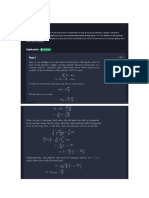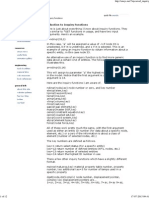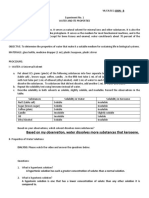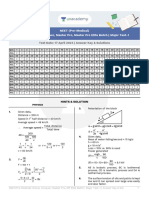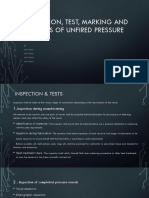MIT16 07F09 hw01 PDF
MIT16 07F09 hw01 PDF
Uploaded by
letter_ashish4444Copyright:
Available Formats
MIT16 07F09 hw01 PDF
MIT16 07F09 hw01 PDF
Uploaded by
letter_ashish4444Original Description:
Original Title
Copyright
Available Formats
Share this document
Did you find this document useful?
Is this content inappropriate?
Copyright:
Available Formats
MIT16 07F09 hw01 PDF
MIT16 07F09 hw01 PDF
Uploaded by
letter_ashish4444Copyright:
Available Formats
NAME : . . . . . . . . . . . . . . . . . . . . .
Massachusetts Institute of Technology
16.07 Dynamics Problem Set 1
Out date: Sept 5, 2007 Due date: Sept 10, 2007
Time Spent [minutes] Problem 1 Problem 2 Study Time
Turn in each problem on separate sheets so that grading can be done in parallel
Problem 1 (20 points) Foam cant hurt the Shuttle?
The space shuttle Columbia was damaged on lifto when a piece of insulating foam from the bipod ramp that holds the shuttle to the external tank came loose, accelerated in the air ow and hit the leading edge of the wing. The wing span of the shuttle is 78 ft. Use 56 ft. as your estimate of the ight path length of the foam in the air stream (see gure).
The incident occurred at an altitude of 65600 ft where the atmospheric density is .000171 slugs/cu ft. The velocity of the shuttle was 2500 fps. The foam block had a cross sectional area of 1 sq ft and a weight of 2 lbs. Assume a drag coecient CD=1.25.
1.- Derive the equation to predict the velocity of the foam as a function of time, as well as the distance traveled as a function of time. Solve this equation using the technique shown in Rectilinear Motion from the Lecture 2 notes. 2.- Show that the velocity of the foam will be about 840 fps when it strikes the wing at a path length of 56. feet. At what time will this occur? Compare this ight time to the recorded ight time from video records (shown): time in hrs.min.sec. Neglect gravity. 3.- How long does it take a uid particle to travel this distance? 4.- Estimate the error from neglecting gravity in part 1. 5.- What impulse is imparted when the foam strikes the leading edge of the wing? 6.- Compare this to the impulse M V imparted by a 17 lb wrench dropped on the shuttle from a height of 150 ft. 7.- I have often wondered whether it would have been better if the foam were lighter or heavier. A lighter form would reach a high velocity but perhaps deliver less impulse. A heavier foam would reach a lower velocity and perhaps deliver a lower impulse. Repeat your calculations xing all initial conditions except the mass M. Take M=2M and then repeat with M=M/2. What is your conclusion? (It is easiest to do this numerically, plugging in various nal velocities into your formulas for x=56.) (You might have read that ice hit the current shuttle on launch.)
Problem 2 (20 points) The technique used to obtain an analytic solution to the governing equation of Problem 1 is not always possible. In this problem, determine the solution by a numerical approach to the solution of the ordinary dierential equation using MATLAB. This will prepare you for our later uses of MATLAB both in the homework and in the extended labs. Use the parameters given in problem 1. run your numerical method and answer the questions posed in problem 1, parts 1.1, 1.2, and 1.7. Become familiar with the numerical approach, explore graphical presentations, have fun. Plot x(t) and v(t) vs. t for parts 1.2 and 1.7.
MIT OpenCourseWare http://ocw.mit.edu
16.07 Dynamics
Fall 2009
For information about citing these materials or our Terms of Use, visit: http://ocw.mit.edu/terms.
You might also like
- Modelling & Simulation 2: Resit Coursework: Task Details & Instructions: SpacecraftDocument3 pagesModelling & Simulation 2: Resit Coursework: Task Details & Instructions: SpacecraftSamin FatimaNo ratings yet
- Student Exploration: Free-Fall LaboratoryDocument6 pagesStudent Exploration: Free-Fall LaboratoryCandeluna LorlanNo ratings yet
- Problems 1Document11 pagesProblems 1LogoNo ratings yet
- Answers To Grade 12U Physics Key Questions Unit 1Document23 pagesAnswers To Grade 12U Physics Key Questions Unit 1Domenico Barillari83% (18)
- Atmosphere FoldableDocument3 pagesAtmosphere Foldableletter_ashish4444No ratings yet
- Bangash, M. Y. H. - Bangash, T-Elements of Spatial Structures - Analysis and Design-Thomas Telford (2003)Document260 pagesBangash, M. Y. H. - Bangash, T-Elements of Spatial Structures - Analysis and Design-Thomas Telford (2003)VinhNguyenThanhNo ratings yet
- Catapult: Using Computers To Do Solve Seemingly Simple ProblemsDocument3 pagesCatapult: Using Computers To Do Solve Seemingly Simple Problemsmh70No ratings yet
- Air Drag and Terminal Velocity NotesDocument3 pagesAir Drag and Terminal Velocity NotesSaumya SinhaNo ratings yet
- Coursework Assignment: LinksDocument9 pagesCoursework Assignment: LinksXady Saud KhanNo ratings yet
- Galoa-Proceedings - SOBENA 2020 - 128671Document8 pagesGaloa-Proceedings - SOBENA 2020 - 128671Lenin ValerioNo ratings yet
- 211Document7 pages211Anonymous Qr763VNo ratings yet
- PSet 01Document3 pagesPSet 01Naren Ka NnanNo ratings yet
- CSU Ph141 Su2020 AnswersDocument15 pagesCSU Ph141 Su2020 Answersmark alisonNo ratings yet
- As Level Physics Topic 3 Kinematics Lessons 1 2 WorksheetsDocument9 pagesAs Level Physics Topic 3 Kinematics Lessons 1 2 Worksheetsapi-183882946No ratings yet
- Glider and PulleyDocument7 pagesGlider and PulleyPaul Jerick LaraNo ratings yet
- 1 D Motion ProblemsDocument3 pages1 D Motion ProblemsAbhay GargNo ratings yet
- Solution 2: Numerical Differentiation and Integration: Problem 1Document5 pagesSolution 2: Numerical Differentiation and Integration: Problem 1Venkat GanapathiNo ratings yet
- Week 2Document2 pagesWeek 2NadaNo ratings yet
- Matlab Project 10Document4 pagesMatlab Project 10Kien LVNo ratings yet
- Past Paper Physics 1st Year BISE Lahore 2005Document3 pagesPast Paper Physics 1st Year BISE Lahore 2005Mian EjazNo ratings yet
- Unit 1 CP Worksheet 1 - Units: Why Are Units Important? Read The Following Story (Which Has Been Excerpted)Document5 pagesUnit 1 CP Worksheet 1 - Units: Why Are Units Important? Read The Following Story (Which Has Been Excerpted)Manuel Aneury Jimenez MendozaNo ratings yet
- Taller #1-Propiedades de Los FluidosDocument1 pageTaller #1-Propiedades de Los FluidosJovan camilo Hernandez GomezNo ratings yet
- Olivia Manganaro - FreeFallSEDocument6 pagesOlivia Manganaro - FreeFallSEOlivia ManganaroNo ratings yet
- Rockets Away: Quadratics and Newton's Third Law of Motion: BackgroundDocument7 pagesRockets Away: Quadratics and Newton's Third Law of Motion: BackgroundPatrick WoessnerNo ratings yet
- TP1HW Dimanalysis-PhasespaceDocument3 pagesTP1HW Dimanalysis-PhasespaceSandro KobuliaNo ratings yet
- Physics 1 - Momentum and ImpulseDocument6 pagesPhysics 1 - Momentum and Impulserafiqsadia86No ratings yet
- Physics JAMB Questions & Explanations Chap GPTDocument20 pagesPhysics JAMB Questions & Explanations Chap GPTFigopec EduNo ratings yet
- Physics KinematicsDocument34 pagesPhysics KinematicsSammasterzNo ratings yet
- 6.302 Feedback SystemsDocument8 pages6.302 Feedback SystemsLuis AntonioNo ratings yet
- CP1c AccelerationDocument20 pagesCP1c AccelerationMysticalNo ratings yet
- Solucion Taller Primer Corte A2Document8 pagesSolucion Taller Primer Corte A2Luis DazaNo ratings yet
- Exercise 2 4Document9 pagesExercise 2 4Evelyn LizárragaNo ratings yet
- ME2050 Exam Mock Exam 2 ScriptDocument9 pagesME2050 Exam Mock Exam 2 ScriptS.A. BeskalesNo ratings yet
- Motion AnalysisDocument13 pagesMotion AnalysisNGAYINTERANYA JanvierNo ratings yet
- Ee 312 Mod 1Document14 pagesEe 312 Mod 1marilou navalNo ratings yet
- Lab Cons. FEMDocument3 pagesLab Cons. FEMhuneNo ratings yet
- Act 2Document3 pagesAct 2Abrar MohamedNo ratings yet
- 5 - Structural Dynamics - R2 PDFDocument151 pages5 - Structural Dynamics - R2 PDFJuan Carlos Torres HernándezNo ratings yet
- Computing For EngineeringDocument4 pagesComputing For Engineeringyuya42No ratings yet
- Homework 6 For Physics ClassDocument3 pagesHomework 6 For Physics ClassrubbadashwubbaNo ratings yet
- Exp7 CollisionsDocument7 pagesExp7 CollisionsJohnBenedictRazNo ratings yet
- TAP222 0 ImpulseDocument16 pagesTAP222 0 ImpulsesagarnitishpirtheeNo ratings yet
- Assignment Version2024.03.19Document5 pagesAssignment Version2024.03.19Mohammad BattalNo ratings yet
- Unit 3 Motion PracticeDocument13 pagesUnit 3 Motion PracticeSadman HasanNo ratings yet
- NSPCH 1Document27 pagesNSPCH 1ishanv_143No ratings yet
- Onservation of Omentum: Timer 1 Timer 2Document5 pagesOnservation of Omentum: Timer 1 Timer 2xellosthetechmanNo ratings yet
- Modern Physics Practice FinalDocument6 pagesModern Physics Practice FinalCurt FreeNo ratings yet
- General Physics Lab Reports 1-12 (Online)Document42 pagesGeneral Physics Lab Reports 1-12 (Online)Rama JarrarNo ratings yet
- Work Sheets in Science 9 Q4 WEEK 1 and 2Document7 pagesWork Sheets in Science 9 Q4 WEEK 1 and 2Je-an Cautibar100% (1)
- (MECH1907) (2021) (F) Final Kbuox7e 32726Document10 pages(MECH1907) (2021) (F) Final Kbuox7e 32726Wish SetsNo ratings yet
- Submarine LabDocument2 pagesSubmarine LabTien NgNo ratings yet
- SubmarineLab (LabStatemen) PDFDocument2 pagesSubmarineLab (LabStatemen) PDFSoftFestivalNo ratings yet
- AE1102 Space Slides 9 10Document64 pagesAE1102 Space Slides 9 10SaraNo ratings yet
- IntroductiontoMATLAB PDFDocument30 pagesIntroductiontoMATLAB PDFncharalaNo ratings yet
- FreeFallSEDocument6 pagesFreeFallSEansonng16888No ratings yet
- Act 2 AgDocument4 pagesAct 2 Agapi-300725936No ratings yet
- CH 2Document4 pagesCH 2Civil NutNo ratings yet
- Chap 39 SMDocument62 pagesChap 39 SMZak GreathouseNo ratings yet
- The Science and Design of the Hybrid Rocket EngineFrom EverandThe Science and Design of the Hybrid Rocket EngineRating: 3 out of 5 stars3/5 (2)
- Python HistoryDocument3 pagesPython Historyletter_ashish4444No ratings yet
- 10 Viscoelasticity 04 Hereditaory PDFDocument12 pages10 Viscoelasticity 04 Hereditaory PDFletter_ashish4444No ratings yet
- Tensile TestingDocument4 pagesTensile Testingletter_ashish4444No ratings yet
- Ceramic: For Other Uses, See - A Ceramic Is An, NonmetallicDocument7 pagesCeramic: For Other Uses, See - A Ceramic Is An, Nonmetallicletter_ashish4444No ratings yet
- Von Mises Yield CriterionDocument4 pagesVon Mises Yield Criterionletter_ashish4444No ratings yet
- NP ChartDocument2 pagesNP Chartletter_ashish4444No ratings yet
- Composite Material PDFDocument10 pagesComposite Material PDFjaviercdeaeNo ratings yet
- Hamilton's PrincipleDocument8 pagesHamilton's Principleletter_ashish4444No ratings yet
- Ansys Quick TipsDocument12 pagesAnsys Quick Tipsletter_ashish4444100% (1)
- Definitions of Financial ManagementDocument2 pagesDefinitions of Financial Managementletter_ashish4444No ratings yet
- Anti-Lock Braking SystemDocument7 pagesAnti-Lock Braking Systemletter_ashish4444No ratings yet
- Trade SecretDocument9 pagesTrade Secretletter_ashish4444No ratings yet
- Predictor-Corrector MethodDocument3 pagesPredictor-Corrector Methodletter_ashish4444No ratings yet
- Control of Nonlinear Electro/Elastic Beam and Plate Systems (Finite Element Formulation and Analysis)Document8 pagesControl of Nonlinear Electro/Elastic Beam and Plate Systems (Finite Element Formulation and Analysis)letter_ashish4444No ratings yet
- Torsion TensorDocument7 pagesTorsion Tensorletter_ashish4444No ratings yet
- Coriolis EffectDocument18 pagesCoriolis Effectletter_ashish4444No ratings yet
- 10 1D2D-Vectors Classwork ProblemsDocument3 pages10 1D2D-Vectors Classwork ProblemsGHOCHULALA AAPTENo ratings yet
- Science 7 Sample DLLDocument4 pagesScience 7 Sample DLLE-Joi del MundoNo ratings yet
- Third Abrasive Wear Mode: Is It Possible?: Short CommunicationDocument3 pagesThird Abrasive Wear Mode: Is It Possible?: Short CommunicationTamara Maria Ortiz MendezNo ratings yet
- CH 0Document16 pagesCH 0abdoag1691998No ratings yet
- US 244499 - Learner GuideDocument27 pagesUS 244499 - Learner GuideMichael NcubeNo ratings yet
- Based On My Observation, Water Dissolves More Substances That KeroseneDocument2 pagesBased On My Observation, Water Dissolves More Substances That KeroseneMaria Isabel Nicole BondalNo ratings yet
- OFC Assignment QuestionsDocument9 pagesOFC Assignment QuestionsPrashant SangulagiNo ratings yet
- Electronegativity - WikipediaDocument19 pagesElectronegativity - WikipediaVadivelanNo ratings yet
- A Versatile Non-Cyanide Gold Plating System: by Ronald J. MorrisseyDocument5 pagesA Versatile Non-Cyanide Gold Plating System: by Ronald J. Morrisseyامين الدينNo ratings yet
- Design of Foundation For Horizontal VesselDocument17 pagesDesign of Foundation For Horizontal VesselSrutha KeerthiNo ratings yet
- Assessments and Rubrics For Unit 2Document13 pagesAssessments and Rubrics For Unit 2api-302258576No ratings yet
- DistillationDocument5 pagesDistillationMaulik sNo ratings yet
- Emittance R Emittance R Config. Factor RDocument6 pagesEmittance R Emittance R Config. Factor RAJNo ratings yet
- USDESDRYERS RegenDesiccantDryers Tcm67 9572Document12 pagesUSDESDRYERS RegenDesiccantDryers Tcm67 9572Sherif AdelNo ratings yet
- Power Plant Technology, El Wakil, Problem 8.14Document33 pagesPower Plant Technology, El Wakil, Problem 8.14Reynold Curampez100% (2)
- XII Electrostatics and Capacitor ModuleDocument127 pagesXII Electrostatics and Capacitor ModuleKS ARPITNo ratings yet
- Answer Key 17-04-2024 Major Test-01Document5 pagesAnswer Key 17-04-2024 Major Test-01DivyanshuNo ratings yet
- Bhec Shankaranarayana Constructions Pvt. LTD., BangaloreDocument15 pagesBhec Shankaranarayana Constructions Pvt. LTD., BangaloreYathishNo ratings yet
- EngineeringDote - Online Entrance Preparation Platform For IOEDocument13 pagesEngineeringDote - Online Entrance Preparation Platform For IOE1paper 1penNo ratings yet
- Azeotrope AssignmentDocument2 pagesAzeotrope AssignmentKamran Zeb100% (1)
- Straub 2022 J. Phys. Conf. Ser. 2198 012027Document9 pagesStraub 2022 J. Phys. Conf. Ser. 2198 012027Christian NissenNo ratings yet
- Notes of CH 13 Magnetic Effects of Electric Current Class 10th Science PDFDocument12 pagesNotes of CH 13 Magnetic Effects of Electric Current Class 10th Science PDFAnonymousNo ratings yet
- Medvedev 2000Document19 pagesMedvedev 2000Ricardo Angelo Quispe MendizábalNo ratings yet
- Solution CH3Document46 pagesSolution CH3roundstorm1100% (1)
- Inspection, Test, Marking and RecordsDocument10 pagesInspection, Test, Marking and RecordssuryaNo ratings yet
- Time Calculation For Pre ActionDocument3 pagesTime Calculation For Pre ActionrajaNo ratings yet
- Hansen Solubility Parameters (HSP) - 1-Introduction - American Coatings AssociationDocument2 pagesHansen Solubility Parameters (HSP) - 1-Introduction - American Coatings AssociationGiovanni TessaroNo ratings yet
- MSL Technical Guide 2 Infrared Thermometry Ice Point: Introduction and ScopeDocument2 pagesMSL Technical Guide 2 Infrared Thermometry Ice Point: Introduction and ScopeEgemet SatisNo ratings yet
- Lab Softening Point TestDocument4 pagesLab Softening Point TestHilman NazriNo ratings yet






























